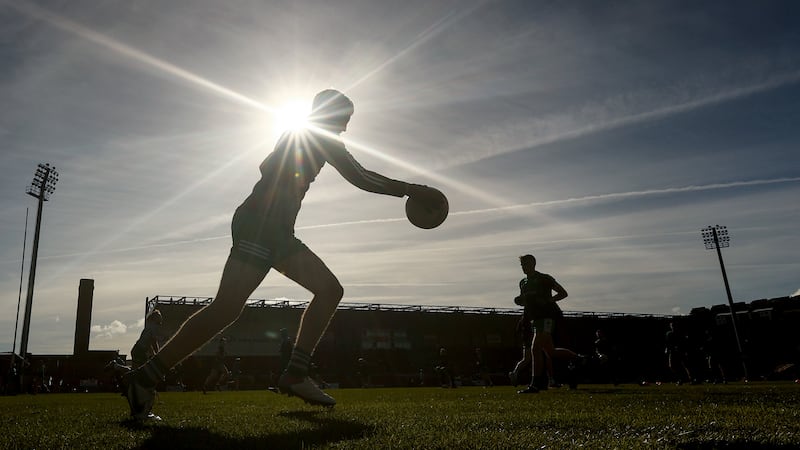After a difficult start at intercounty when I first played championship in my teens, but very little national league because of knee and hip surgery, I started to understand my body and what worked.
Learning from various physios and strength and conditioning people, I found methods that were comfortable for me and not necessarily what everyone else was doing. Until a hamstring injury late in my career, I managed to do what was necessary to keep me out on the pitch.
There’s a personal story behind every injury as well, even though we tend to view it through the lens of what impact it has on a team. Paddy Lynch’s injury was completely, rightly or wrongly, tied up with Cavan’s season. Eoin McEvoy and Pádraig McGrogan have been stark absences for Derry.
Paddy Durcan is the key piece in Mayo’s half-back line as well as the captain. Aimee Mackin – my God, what she does for Armagh and then her brother Ciarán, who was having a great season.
READ MORE
Damien Comer is probably Galway’s most important player and he’s out for a while.
Injury creates anxiety – “when will I recover” – and uncertainty – “will I be as good on my return?”. There’s also the social pressure of everybody asking at work or on the street: “How are you?” “Is it any better?” “Do you think you’ll make it?”
I can’t imagine a time when county players have been more diligent, harder working or better supported. The common language is around GPSs, MRIs, prehab, rehab, and grades of injuries, but the litany of high-profile injuries is striking.
There’s an element of misfortune in all injuries, but if a team go out and kick 10 wides or concede too many goals, we do absolutely everything in our power to address the problem. There’ll be a tactical change or personnel switches.
Is there some other way of mitigating the risk involved in these injuries? I know the GAA 15 warm-up was brought in a number of years back. That is designed to limit the big injuries in a GAA context, to the knee, ankle, hamstring and groin just as in soccer there is the Fifa 11+.

The problem with these programmes is that they take quite long – 20 minutes at least – when time is of the essence at training sessions and there’s probably a slight overemphasis on the tactical side of preparation.
Viewed in the wider scheme of things, a proven strategy to improve outcomes with these injuries is surely worth a few more minutes of warm-up. Look again at that list of high-profile injuries and how season defining it is for teams and individual players.
Broaden it out from the intercounty scene. At a recent training session with the club, Glenswilly, we had eight to 10 senior players training for nearly a week and a half. We had probably the same number on the sideline with back, hamstring and calf injuries.
I’m not sure if it’s gym work but younger players look to me to be carrying more bulk. I know that senior players in general do more in the gym than they would have done before. That increased bulk on bodies means that when you twist and turn, there’s more torque going through the body. That can potentially lead to a knee giving way.
When you can state at the start of the year that we’re going to do this, that and the other tactically and be competitive in our attacking and defensive game plans, what is the right model for a strategy to keep players fit on the pitch and able to play?
Go back over recent All-Ireland winners and I would suggest a strong correlation between winning and player availability. Teams that lose key players obviously haven’t the same probability of winning, especially at the latter stages.
[ Seán Moran: How to make GAA championship fit for purpose in modern societyOpens in new window ]
Dublin’s injury record strikes me as amazing and I can’t think of any huge injury troubles they have had during the last decade. There was a couple of high-profile cruciate injuries but over 10 years I can’t think of too many key players that had to miss big matches because of injury.
We also really need to learn from each other. The GAA has made strides towards a national injury surveillance database to track the intercounty football and hurling games, set up in 2008, and expanded to include academy players in more recent times.
It has been very much an opt-in project. Then you have the usual levels of secrecy – teams wanting to keep a lot of their practices and information in-house and not necessarily wanting to collaborate.
There are also the new schedules. Originally there was a far more gradual build-up to the season and you had a bigger window for competitions like the national league. There was room for a four- to six-week block before championship.
Now you have to build up the base a lot more quickly and it spikes because of the shorter period of time, which leaves you more susceptible to injury. You have to get up the levels a lot quicker, as there’s more riding on the national league with championship status on the line.
Finding the best tactical approach to matches is important and a lot of time is spent on that, but without the best players available and on the pitch, it’s all a bit futile.
















